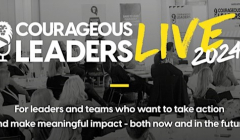
Embracing empowerment and relinquishing control
At Courageous Leaders Live 2024 leaders discuss the importance of time, feedback and making space for others

With the cost of living crisis topping the industry agenda we asked a selection of leaders to predict what lies ahead for the brand experiences sector.

Welcome to the polycrisis. Inflation, supply chain crisis, cost of living crisis. While as an industry and as individuals we want nothing more than the certainty of a post-Covid recovery, the reality remains that the market is challenging. It is a particularly painful reality for the events industry; a sector still reeling from the economic and emotional impact of extended lockdowns.
We are already seeing experiences like Glastonbury having to hike up the price of tickets to balance out increased costs. Will more events and experiences follow suit? In an uncertain market questions remain as to what innovations might come to the fore in 2023.
With this in mind, we asked a selection of industry experts what brand experiences will look like in 2023.

After two years of lockdown, followed by the aforementioned poly-crisis, common sense would dictate that as a digital-forward nation, we’d have finally found joy in the more efficient and cost effective way to enjoy events and experiences through the screen. But as someone who made the very grown up [aka. Absolutely f**king terrible] decision to save money and not go to Glasto this year, leaving me miserably flicking through iplayer into the dead of night instead of dancing the night away at Shangri La - let me tell you - a digital experience ‘doesn’t a good event maketh’.
Research recently commissioned by John Lewis has decreed the 2020s ‘the rise of the moment economy’ where people seek real, human relationships over digital ones. For this reason I firmly believe that ‘more digital integration will not be the answer’. Just ask Taylor Swift, who sold a record breaking 2 million tickets in a single day with her needing to play 900 stadium shows to meet the real demand from fans [that’s an additional 2.5 year tour].
I believe the growing appetite from consumers for real life live events will force the hands of organisers to get creative with the format, instead of one-off events with huge wastage organisers will be looking at other real estate - I predict more in-store environments being used as an entertainment destination - bringing commerce and engagement together in a more intimate setting.
We’ll also start to see more pop ups events and roadshows over the one-offs with plenty of opportunities to make the event a key content capture moment to really sweat that investment.
So far, the squeeze on discretionary spending doesn’t seem to be deterring consumers away from IRL - the more cost effective pull of the metaverse doesn’t seem to have moved past a gimmick just yet for the masses - in other words, VIVA LA LIVE.

I think there is likely to be different approaches to events and experiences in 2023 based on the audience a brand is trying to reach. If we dimension it in terms of age and income – older consumers with higher disposable income will likely be reasonably unaffected and still seek out premium IRL events and experiences (just look at legacy rock and pop acts selling out at high ticket prices).
At the other end of the spectrum, younger audiences with less disposable income will inevitably head online and into the ‘metaverse’ (Fortnight concerts from the likes of Travis Scott and Marshmello in recent years show us how that can be successful).
I suspect where it will get interesting is somewhere in the middle – will we start to see more hybrid events where yes you can pay the higher price to attend in person, but for those unable to there is a digital alternative. The likes of Megan Thee Stallion, Billie Eilish and Imagine Dragons have all partnered with brands and tech platforms to make this happen in the last 12 months using VR.
The play for brands will be to consider how they can take a two-tier approach that is inclusive and enables them to sweat any investment to maximise returns.

Zoom cocktails and metaverse concerts are one of the few ways we could make a cost-of-living crisis even worse. Haven’t people been through enough?
Innovations in the world of virtual experiences are inevitable - but they’ll never replace in-person experiences, especially not during a recession.
Cost-of-living crisis and supply chain issues don't transform people into couch potatoes. However, consumers will start to re-prioritise, evaluating the value of experiences more than ever. Meaning that your free branded experience is now worth less than nothing. No one values a free metaverse cocktail.
Charging for experiences is perhaps the most counterintuitive move a brand could make during a recession – but it might be their only hope.
The 'lipstick index' is an observed phenomenon that makeup sales skyrocket during times of economic upheaval. It’s the idea that affordable luxuries become desirable during a recession. This will become even more pronounced in the world of experiences – especially after customers spent 2 years in lockdown.
Charging for “affordable luxury” branded experiences is one of the only recession-proof brand strategies.
Any brand can get in the ‘affordable luxury’ experience game. Kraken Rum’s Dread and Breakfast or Ford Go Faster (full disclosure, an Imagination project) are two of my favourites that show brands having fun, connecting with consumers in new ways, and maybe even making a profit.

For big brands, the effect of the cost of living on experience for their customers will be minimal. They can draw in audiences to their events at higher prices, offsetting operational costs, without the worry of losing attendances. Medium and smaller brands and organisations are the ones that need to rethink their engagement strategy. Mainly, because the cost level will change what the experience will be.
Medium and small brands should consider a number of things for 2023:
Digital experiences need to become more human. Experiences will have to be smarter in entertainment value and drive live sharable content through social platforms, growing particularly among Gen Z audiences. They need to position themselves as humanised partners with positive change initiatives.
Immersive and virtual experiences will become the norm. Companies have already played in this space during the pandemic. So, they need to continue to create virtual branded experiences for marketing events, concerts, and meetups to engage their customers in a unique way. With the emergence of the metaverse, this will not only bring people together but allow them to create, collaborate and even purchase.
Physical and digital hybrid experiences will extend the customer engagement. Experiential marketing that blends virtual and in-person experiences can capitalise on social data. Ben and Jerry’s ‘Tweet the Truck’ concept showed how the brand offered free samples of its newest ice cream flavour, allowing shoppers to tweet where the truck should go, instead of staying in one location.
Finally, 2023 is a great time for smaller brands to have boutique experiences. These brands know much more about different parts of their business and can provide more bespoke human experiences with personalised services. For example, leveraging digital pop-up shops with NFT to increase marketing engagement.
Looks like you need to create a Creativebrief account to perform this action.
Create account Sign inLooks like you need to create a Creativebrief account to perform this action.
Create account Sign in